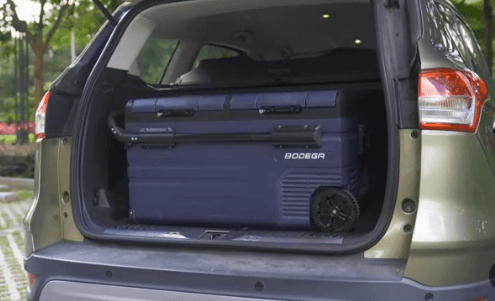Have you ever pondered the question, “How much power does my overland fridge use?”
Overlanding and camping are more than just hobbies for many outdoor enthusiasts—they’re a lifestyle. The overland fridge is Integral to this lifestyle, keeping your food fresh and drinks cold wherever you venture. The power consumption of these essential appliances can significantly impact your journey, so it’s crucial to understand it.
In this blog post, we will unravel the mystery behind the power consumption of overlanding fridges. We’ll delve into how power consumption is measured, the factors that affect it, and how it compares with residential fridges. Moreover, we’ll explore how to manage and reduce the power consumption of your overland fridge. So, strap in as we embark on this enlightening journey together.

Understanding Power Consumption
Power consumption for appliances like fridges is often measured in watts or kilowatt-hours. Watt is a unit of power, representing the rate at which energy is used. If an appliance uses power at a constant rate over time, you can calculate the total energy used in kilowatt-hours, which is typically how energy use is billed. For example, if your fridge uses 60 watts of power constantly over an hour, it has used 0.06 kilowatt-hours of energy.
The average power consumption of overland fridges can vary based on their make and model. Depending on operating conditions, it typically ranges between 1 to 5 amps per hour when running on a 12-volt power source. However, remember that the fridge’s compressor doesn’t run continuously—it cycles on and off as needed to maintain the temperature, so the actual power usage will be lower.
Factors Affecting Power Consumption
Many factors can affect the power consumption of overland fridges.
Size of the Fridge
The physical size of the fridge is one of the primary determinants of its power consumption. Larger fridges have a greater internal volume to cool, which requires more energy. On the other hand, smaller fridges have less space to cool, thus utilizing less energy. However, it’s a delicate balance, as getting a fridge that’s too small could lead to frequent door openings, which would also increase energy usage. Choosing a fridge size that perfectly fits your overlanding needs is critical.
Temperature Settings
The temperature at which you set your fridge can significantly impact its power consumption. Lower temperature settings mean the fridge needs to work harder to maintain that temperature, leading to increased power usage. On the other hand, a slightly higher temperature setting could mean less energy use. Keeping the fridge at a consistent, safe temperature that isn’t colder than necessary is recommended to ensure your food stays fresh without wasting energy.
Quantity & Types of Items
The amount and type of items stored in the fridge can also affect its power consumption. A fully stocked fridge is more energy-efficient than an empty one, as the items inside will help retain the cold, reducing the need for the fridge to cycle on frequently. Furthermore, the type of items matters as well. For example, putting hot leftovers directly into the fridge would require more energy to cool down compared to letting them reach room temperature first.
Frequency of Door Openings
How frequently the fridge door is opened and how long it stays open can significantly influence power usage. Each time the fridge door is opened, cold air escapes, and the fridge must work harder to restore the lost coolness. Minimizing unnecessary door openings can go a long way in reducing energy consumption.
Surrounding Temperature
The ambient temperature around the fridge plays a significant role in power consumption. If the surrounding temperature is high, the fridge has to work harder to maintain its internal temperature, leading to more energy usage. Hence, keeping the fridge in a cooler location, away from direct sunlight or heat sources, can help conserve power.

Quality of Insulation
The quality of the fridge’s insulation can affect how well it maintains its internal temperature and, thus, its power consumption. A fridge with poor insulation might struggle to keep its contents cool, especially in hot weather, leading to a higher power draw. On the other hand, a well-insulated fridge will operate more efficiently, helping you save on energy consumption.
Fridge’s Age and Condition
Older fridges or those in poor condition might consume more power than newer, well-maintained ones. Over time, wear and tear can cause a fridge to lose efficiency. Regular maintenance, cleaning, and timely repairs can ensure your fridge remains in good working condition and operates at optimal energy efficiency.
Comparing Power Consumption of Overland and Residential Fridges
Overland fridges and residential fridges serve the same purpose but operate quite differently, especially when it comes to power consumption. A typical residential fridge uses between 100 to 400 watts, depending on its size and model. This figure might seem larger than an overland fridge, but it’s important to remember that residential fridges are connected to a continuous power supply and are designed for larger capacity.
The difference in power consumption is primarily due to design and insulation. Residential fridges are larger, better insulated, and use different cooling technology. However, overland fridges are designed to be portable, energy-efficient, and run on a battery, often solar-powered, making them ideal for outdoor use. While they might use less power, they also have less capacity than their residential counterparts.
Managing Power Consumption of an Overland Fridge
Now that we know what affects power consumption, let’s look at some ways to manage it. Effective organization of your fridge can improve its efficiency. It’s good practice to ensure your fridge is well stocked, as a full fridge retains cold better than an empty one. Pre-cooling your food and drinks before storing them in the fridge can also significantly reduce power consumption, as the fridge won’t have to work as hard to cool them down.
Choosing the right battery for your overland fridge is another crucial step in managing power consumption. Investing in a deep-cycle battery is a smart move for longer trips, as they are designed for regular and significant discharging. In addition, incorporating solar power into your energy system can provide an excellent, sustainable power source during sunny weather conditions. This not only helps manage the energy consumption of your overland fridge but also contributes to a more eco-friendly adventure.
Using energy-saving accessories like insulating covers can further reduce power consumption. An insulating cover helps maintain the fridge’s internal temperature, decreasing the need for the compressor to kick in frequently. This can save a considerable amount of energy, especially in hotter climates.

Final Words: How Much Power Does My Overland Fridge Use?
Understanding how much power your overland fridge uses is a good practice and a necessity when you’re off-grid, depending on a limited power supply. By understanding the factors that influence power consumption, such as fridge size, temperature settings, and the surrounding temperature, you can make informed decisions and take steps to manage it.
You can significantly reduce your fridge’s power consumption by adopting simple practices like efficient fridge organization, using pre-cooled items, and investing in the right kind of batteries and energy-saving accessories. This helps you manage your energy resources better and makes your overlanding experience more enjoyable and sustainable.





